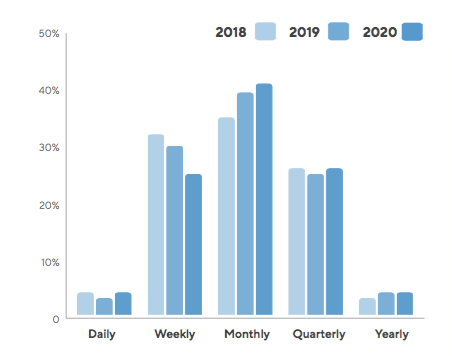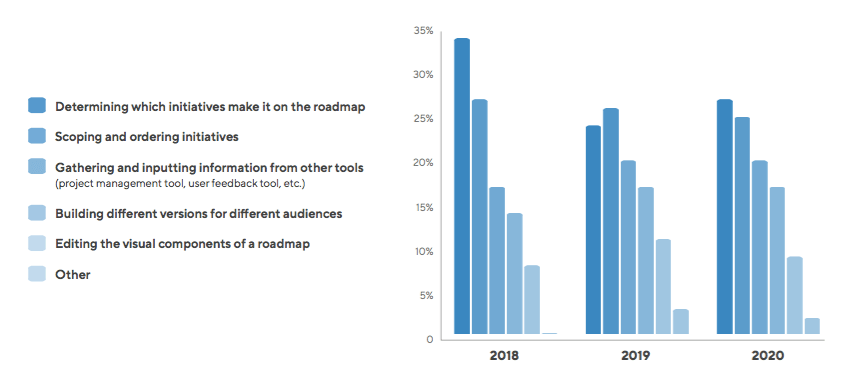Creating a roadmap shouldn’t happen in an afternoon. It should be the product of numerous meetings, research exercises, data dives, prioritization activities, and strategy sessions. There’s no right answer to the question of “how long should it take?” But stepping back, we can analyze which steps chew up the largest chunks of time for product management during the roadmapping process. In our 2020 Product Managers Report, we discovered which were the most time-consuming aspects of the process.
Given that 41% of product managers are revising their roadmap monthly, this isn’t just an interesting anecdote. These tasks account for a significant part of a product manager’s work life. Understanding which takes longest can shine a light on opportunities to improve the overall process and reveal some efficiencies.

Below we’ll examine the most time-consuming phases of the roadmapping process and suggest some strategies for speeding things up without sacrificing quality.
Time-Consuming Aspects of Roadmapping

Determining which initiatives make it on the roadmap was the most time-consuming roadmapping task for 27% of respondents. Deciding what’s worthy of a coveted slot on a product roadmap requires product managers to consider many factors. These include (but are certainly not limited to):
- Customer value
- Are prospects demanding this?
- Will it increase product usage?
- Will buyers pay more if this is present?
- Is the product experience unsatisfactory without it?
- Business goals
- Will this item impact a KPI?
- Does this advance the North Star metric?
- Is this essential for the company strategy?
- Will it stoke growth or reduce churn?
- Cost of delay
- What happens if we don’t do this soon?
- Has a competitor already introduced this offering?
- Is there revenue directly tied to this item?
- Are there cybersecurity or technical debt implications?
These questions can (and should) be asked for everything being contemplated as a potential roadmap item. However, figuring out the answers can take a lot of time and energy.
To keep the roadmapping process from grinding to a halt while answering these questions is to address them at a regular cadence. Every time a potential roadmap item arises, these topics can be considered and documented as part of the initial vetting process.
That way, the product team and other stakeholders have all the information they need to make the “in or out” decision during each roadmap cycle. While holding everything up to the same product vision lens, it’s far easier to “thin the herd” of potential roadmap-worthy candidates.
Sizing and sorting
Scoping and ordering initiatives was the second-leading response, at 25%. This encompasses two, interdependent challenges of roadmapping.
Every development item is different. They take different amounts of time, require different expertise, and might even come with extra costs (be it licensing something from a third party or impacting storage and processing demands).
Ignoring these realities and treating every feature as interchangeable widgets of engineering is naive and dangerous. Product managers need accurate and fundamentally sound roadmaps, and that entails understanding and planning for level of development effort on each feature.
It’s impossible to know exactly how long something will take or what’s ultimately required until you actually build it. But most successful teams get pretty good at scoping these things out in advance. Only once an item up for consideration has been at least cursorily sized can it be fairly compared to the alternatives jockeying for a roadmap slot.
Luckily, there are a plethora of methods available for product managers and their extended teams to bring some logical structure to this process. Prioritization frameworks offer a way to build alignment and incorporate multiple viewpoints while figuring out the best order to address potential enhancements.
Among the most popular prioritization frameworks, many factor in the effort as part of the process. For example, it’s the “e” in the RICE Scoring Model.
Other top frameworks cut through the noise and get down to determining the must-haves, should-haves, and could-haves, such as the MoSCoW framework. Product managers can also use weighted scoring right in ProductPlan by leveraging the Planning Board functionality.
If the sheer number of choices seems overwhelming, there’s also a helpful guide to finding the best framework for the situation at hand. And you can rest easy knowing that there’s no “lock-in” when it comes to prioritization frameworks. Many organizations use different ones all the time.
Corralling data
Gathering and inputting information from other tools was the top time-consuming aspect of roadmapping for 20% of respondents. They found syncing data from project management, user feedback, and other tools the most difficult part of roadmapping.
Product managers should have a healthy product stack at their disposal, as these tools all do different things. There’s a solid business case for securing a budget to build up the product management toolbox.
But with an arsenal of great solutions for various aspects of product management, getting them all to play nice together isn’t always easy. The ideal solution is utilizing a roadmapping tool that integrates with the other utilities already in use.
For ProductPlan customers, there’s baked-in support for a variety of tools product managers and their co-workers use. These include Jira, GitHub, Slack, Pivotal Tracker, Trello, Azure DevOps, and Confluence. If a company is using other products, there’s also the ability to use the REST API to integrate with other systems.
Beyond those options, product managers can also minimize the need to go back-and-forth between tools. Take the new, incoming data and update things in a single system of record as it comes. For example, if product managers are scoring potential roadmap items on the Planning Board, they can simply update or add to items on there instead of trying to manage things in two places.

Tailor Your Roadmap
Creating a tailored version of roadmaps for different audiences takes the most time for 17% of respondents. These product managers are laboring over presenting roadmaps that only contain the pertinent information for each cohort of stakeholders they’re dealing with.
It’s an incredibly important aspect of presenting roadmaps. It shields product managers from unnecessary conversations and makes the roadmap’s content clear, concise, and relevant for the given audience.
Whether it’s for executives, IT, investors or board members, the sales team, or even an all-hands meeting, what gets left out is just as critical as what’s presented. As a rule, less is usually more.
Substituting themes for features and milestones for dates will make a roadmap more portable, but product managers still need that master roadmap to remain intact. That’s why a tool that supports multiple custom views can be a huge time-saver for product teams.
Visualizing their roadmap
For 9% of respondents, they’re spending the most time on editing the visual elements of roadmaps. As anyone who’s created a roadmap in PowerPoint can attest, this can be an endless exercise. Every edit, comment, or tweak creates a ripple effect requiring additional rejiggering.
This is another area where a purpose-built roadmapping tool makes a massive difference. Starting with pre-defined templates and leveraging the simplicity of drag-and-drop authoring, beautiful roadmaps are seamlessly generated in real-time, using clear text and bright colors to convey the product vision.
Not only can this save enormous amounts of time, it inevitably results in a more attractive and compelling roadmap. Plus, it allows product managers to make those inevitable changes and then generate custom views without having to reformat everything.

Always Room for Improvement
Roadmaps are one of the most powerful ways to align stakeholders and rally the organization around a plan for executing the product vision. But whether you’re building your first roadmap or are cranking out the plan for Version 17 — there are always opportunities to streamline the process.
Roadmapping doesn’t need to be a grueling chore. With the right techniques and tools, you should have a roadmap the whole team can be proud of.




